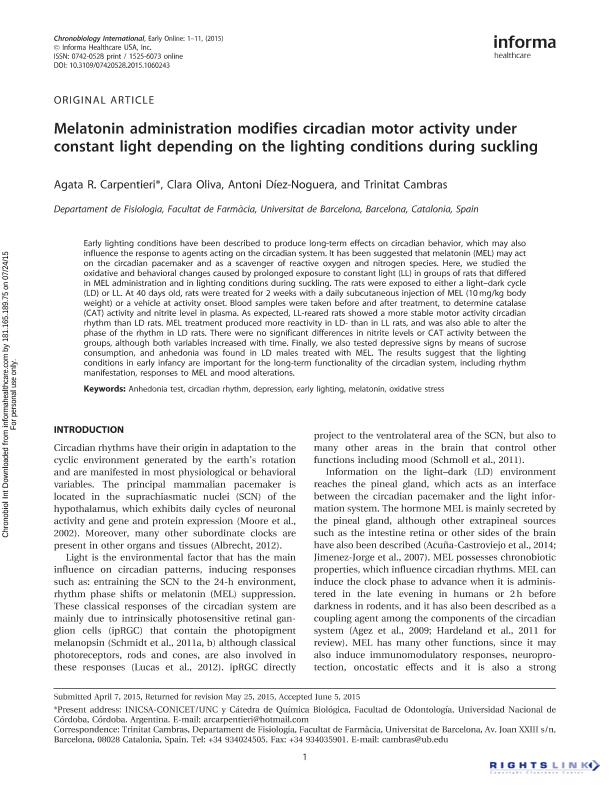Mostrar el registro sencillo del ítem
dc.contributor.author
Carpentieri, Agata Rita

dc.contributor.author
Oliva, Clara
dc.contributor.author
Diez Noguera, Antoni
dc.contributor.author
Cambras, Trinitat
dc.date.available
2017-01-13T21:17:45Z
dc.date.issued
2015-07
dc.identifier.citation
Carpentieri, Agata Rita; Oliva, Clara; Diez Noguera, Antoni; Cambras, Trinitat; Melatonin administration modifies circadian motor activity under constant light depending on the lighting conditions during suckling; Taylor & Francis; Chronobiology International; 32; 7; 7-2015; 994-1004
dc.identifier.issn
0742-0528
dc.identifier.uri
http://hdl.handle.net/11336/11358
dc.description.abstract
Early lighting conditions have been described to produce long-term effects on circadian behavior, which may also influence the response to agents acting on the circadian system. It has been suggested that melatonin (MEL) may act on the circadian pacemaker and as a scavenger of reactive oxygen and nitrogen species. Here, we studied the oxidative and behavioral changes caused by prolonged exposure to constant light (LL) in groups of rats that differed in MEL administration and in lighting conditions during suckling. The rats were exposed to either a light–dark cycle (LD) or LL. At 40 days old, rats were treated for 2 weeks with a daily subcutaneous injection of MEL (10 mg/kg body weight) or a vehicle at activity onset. Blood samples were taken before and after treatment, to determine catalase (CAT) activity and nitrite level in plasma. As expected, LL-reared rats showed a more stable motor activity circadian rhythm than LD rats. MEL treatment produced more reactivity in LD- than in LL rats, and was also able to alter the phase of the rhythm in LD rats. There were no significant differences in nitrite levels or CAT activity between the groups, although both variables increased with time. Finally, we also tested depressive signs by means of sucrose consumption, and anhedonia was found in LD males treated with MEL. The results suggest that the lighting conditions in early infancy are important for the long-term functionality of the circadian system, including rhythm manifestation, responses to MEL and mood alterations.
dc.format
application/pdf
dc.language.iso
eng
dc.publisher
Taylor & Francis

dc.rights
info:eu-repo/semantics/openAccess
dc.rights.uri
https://creativecommons.org/licenses/by-nc-sa/2.5/ar/
dc.subject
Melatonin
dc.subject
Circadian Rhythms
dc.subject
Synchronization
dc.subject
Constant Light
dc.subject.classification
Bioquímica y Biología Molecular

dc.subject.classification
Ciencias Biológicas

dc.subject.classification
CIENCIAS NATURALES Y EXACTAS

dc.title
Melatonin administration modifies circadian motor activity under constant light depending on the lighting conditions during suckling
dc.type
info:eu-repo/semantics/article
dc.type
info:ar-repo/semantics/artículo
dc.type
info:eu-repo/semantics/publishedVersion
dc.date.updated
2017-01-13T19:42:25Z
dc.identifier.eissn
1525-6073
dc.journal.volume
32
dc.journal.number
7
dc.journal.pagination
994-1004
dc.journal.pais
Reino Unido

dc.journal.ciudad
Milton Park
dc.description.fil
Fil: Carpentieri, Agata Rita. Universidad de Barcelona. Facultad de Farmacia; España. Consejo Nacional de Investigaciones Cientificas y Tecnicas. Centro Cientifico Tecnologico Cordoba. Instituto de Investigaciones en Ciencias de la Salud; Argentina. Universidad Nacional de Córdoba; Argentina
dc.description.fil
Fil: Oliva, Clara. Universidad de Barcelona. Facultad de Farmacia; España
dc.description.fil
Fil: Diez Noguera, Antoni. Universidad de Barcelona. Facultad de Farmacia; España
dc.description.fil
Fil: Cambras, Trinitat. Universidad de Barcelona. Facultad de Farmacia; España
dc.journal.title
Chronobiology International

dc.relation.alternativeid
info:eu-repo/semantics/altIdentifier/doi/http://www.tandfonline.com/doi/full/10.3109/07420528.2015.1060243
Archivos asociados
